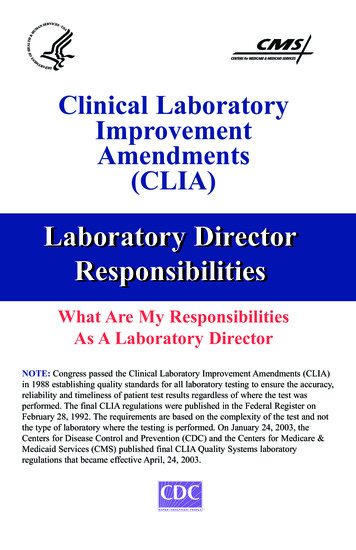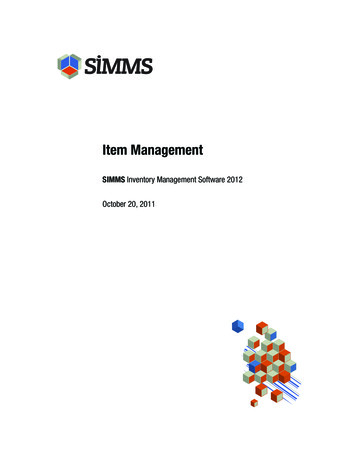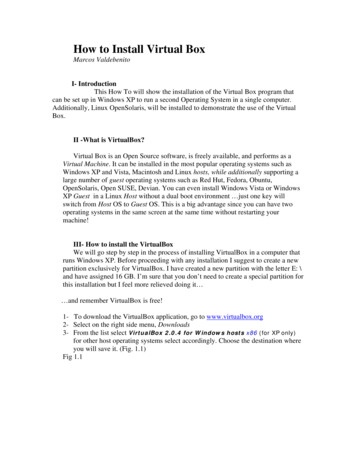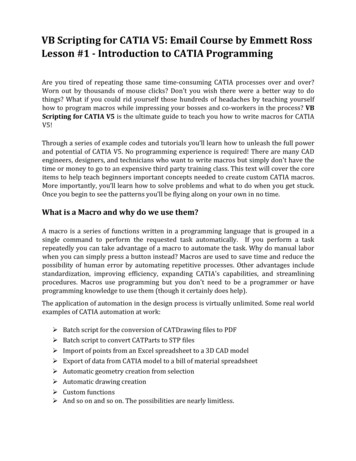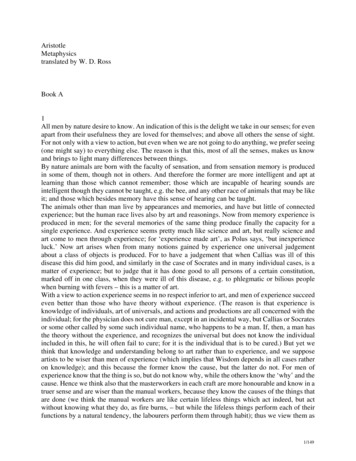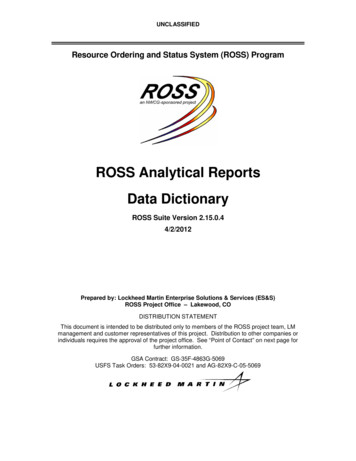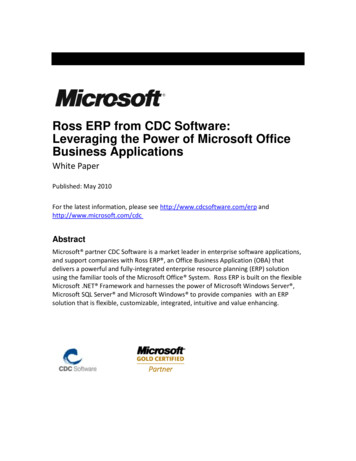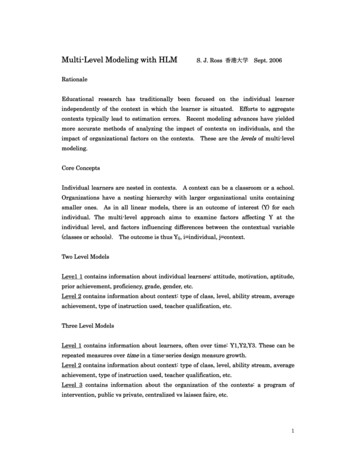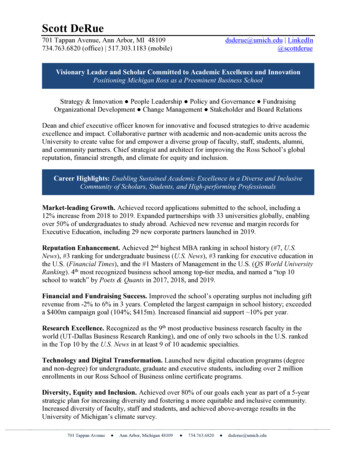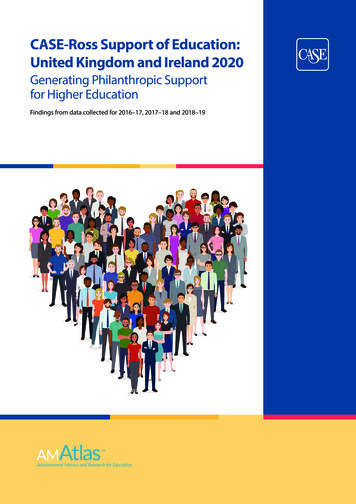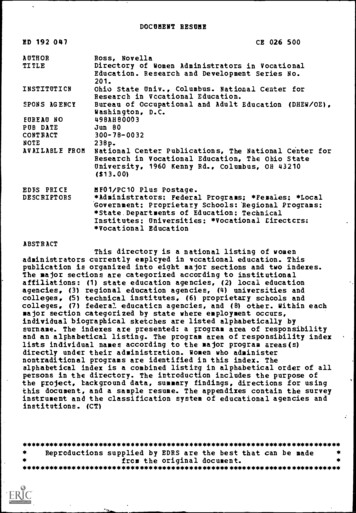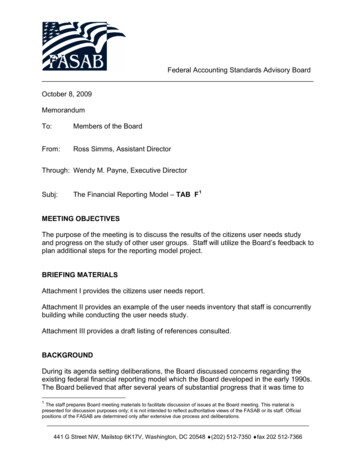
Transcription
Federal Accounting Standards Advisory BoardOctober 8, 2009MemorandumTo:Members of the BoardFrom:Ross Simms, Assistant DirectorThrough: Wendy M. Payne, Executive DirectorSubj:The Financial Reporting Model – TAB F 1MEETING OBJECTIVESThe purpose of the meeting is to discuss the results of the citizens user needs studyand progress on the study of other user groups. Staff will utilize the Board’s feedback toplan additional steps for the reporting model project.BRIEFING MATERIALSAttachment I provides the citizens user needs report.Attachment II provides an example of the user needs inventory that staff is concurrentlybuilding while conducting the user needs study.Attachment III provides a draft listing of references consulted.BACKGROUNDDuring its agenda setting deliberations, the Board discussed concerns regarding theexisting federal financial reporting model which the Board developed in the early 1990s.The Board believed that after several years of substantial progress that it was time to1The staff prepares Board meeting materials to facilitate discussion of issues at the Board meeting. This material ispresented for discussion purposes only; it is not intended to reflect authoritative views of the FASAB or its staff. Officialpositions of the FASAB are determined only after extensive due process and deliberations.441 G Street NW, Mailstop 6K17V, Washington, DC 20548 (202) 512-7350 fax 202 512-7366
revisit the model. The plan for revisiting the model included 1) studying user needs forfederal financial information; 2) determining the inventory of user needs and how theyrelate to the reporting objectives; 3) determining methods for meeting user needs; and4) determining presentations. Currently staff is studying user needs and building a userneeds inventory. The user needs study involves focus group discussions with variousgroups including individuals with expertise in presenting information in federal financialreports (preparers), other federal financial reporting experts, auditors, and citizens, andinterviews of citizen intermediaries, Congressional staff, executives, and programmanagers. In addition, staff conducted a national survey of citizens and is conducting aliterature review to identify information that should be reported to facilitate decisionmaking and demonstrate accountability.PROGRESSStaff has concurrently studied each user group and has completed planned steps forthe study of citizens user needs (see Attachment I for details of the citizens user needsstudy). Because citizens, Congress, executives, and program managers share some ofthe same information needs and may at times obtain information from each other, staffsuggests developing conclusions and recommendations after staff completes the userneeds studies for the remaining user groups (see pages 10-11 of Attachment I for adiscussion on the next steps). Chart 1: Reporting Model Timeline, on page 3, showsthe estimated completion dates and that progress can be made on all phases intandem.Regarding progress on the remaining user groups, staff initiated a survey ofCongressional staff. However, due to the low response rate, staff plans to conductinterviews. In addition, staff has conducted focus group discussions with preparers,other federal financial reporting experts, and auditors and is in the process ofconducting interviews with executives and managers. Moreover, staff is reviewingliterature which would consider the information needs of all the user groups andreporting model presentation matters. The literature review includes GovernmentAccountability Office (GAO) reports and guidance, congressional hearings, andliterature on the operations of Congress and program management principles. Staff iscompiling the user needs study results in a user needs inventory. An example of theinventory is provided in Attachment II. The inventory as of September 2009 is primarilybased on the literature review. In addition, Attachment III shows the referencesconsulted during the course of the user needs study to date.2
Chart 1: Reporting Model TimelineDetermine PresentationDetermine Needs InventoryUser Needs StudyOctober-09Determine Methods to meet 10July-10SeptNovememberber-10-10Estimated Completion DatesUser Needs StudyDetermine Needs InventoryDetermine Methods to meet NeedsDetermine PresentationSTAFF QUESTIONS TO THE BOARD1. Does the Board agree with the staff proposal to complete the user needs study forall groups before developing conclusions and recommendations?2. Does the Board have comments or suggestions for additional research regardinguser needs?If you have questions or need additional information, please contact me at202-512-2512 or by email at simmsr@fasab.gov as soon as possible. I will be able toconsider and respond to your request more fully in advance of the meeting.Attachments3
Attachment IFINANCIAL REPORTING MODELUSER NEEDS STUDYCITIZENS1
PurposeThe purpose of the citizens user needs study was to determine what type of informationshould be provided to citizens to assist them in assessing the federal government’saccountability and in making decisions with respect to the federal government.Ultimately, staff intends to use the results to develop an inventory of user needs.BackgroundIn the mid-80s, the Government Accountability Office (GAO) and the Office of theAuditor General of Canada (OAGC) published a study on users’ “needs” regardingfederal government financial information. The report entitled Federal GovernmentReporting Study (FGRS) noted that “ identifying and understanding users’ activitiesand financial information needs are the starting point for building consensus about theform and content of financialreports.” 1 It also discussed thatusers depend on each other forUnderstandable reports directed to citizens about theinformation and it described thestewardship exercised on their behalf by their nationaltypes of information that usersgovernment are not a panacea, but they can makedemocracy and government more effective in severalseek, such as information onways.what are the full cost of-Toward a Report to Citizens on the State of Their Nation and theprograms, what does thePerformance of Their Government, Association of Governmentgovernment own, what does theAccountants, November 1994government owe, what are thesources of revenues and how arerevenues spent. 2Regarding citizens in particular, FGRS noted that this group typically does not usefinancial reports. Instead, they rely on analyses and reports from the media. 3 FGRSasserts that, “ Federal government financial reports will serve the needs of legislators,citizens and corporations well only if the needs of the media and analysts areadequately met.” 4 Media and analysts believe that preparing financial reports andhaving them audited would instill discipline and provide confidence in other federalgovernment financial reports, and that an annual financial report about the federalgovernment would serve as a useful reference document for further research. 5Subsequent to the FGRS, in the early 1990s, the Federal Accounting StandardsAdvisory Board (FASAB) began its mission and developed conceptual guidance thatdescribes the information that would be used by four groups of users – citizens, whichincludes the media and analysts; congress; executives; and program managers. Theinformation they would use may be categorized as: budgetary integrity information,operating performance information, stewardship information, and systems and control1FGRS, GAO/AFMD-86-30B, p. iv.Ibid, pp. 10 and 11.3Ibid. p.104FGRS p.6.5Ibid, pp. 67, 68, and 110.21
information. These categories provide the framework for the objectives of federalfinancial reporting. The reporting objectives are discussed in Statement of FederalFinancial Accounting Concepts (SFFAC) 1, Objectives of Federal Financial Reporting(Objectives). In addition, SFFAC 4, Intended Audience and Qualitative Characteristicsfor the Consolidated Financial Report of the United States Government, states thatcitizens and citizen intermediaries should be the primary audience for the consolidatedfinancial report of the federal government. 6Given several years of substantial progress in federal financial reporting since the GAOand OAGC study and the development of the existing reporting model, the FASABbelieved that it was time to revisit the model and the information “needs” of users. Theproject will revisit the federal financial reporting model for individual departments andagencies and government-wide reporting.Scope and MethodologyThe FASAB staff, with assistance from the GAO Applied Research and Methodology(ARM) staff, conducted focus group discussions to: (1) learn what information should beprovided to individual citizens about the federal government; and (2) provide insights onhow financial reports 7 could be improved to facilitate their use for assessingaccountability and decision-making. Focus groups are not designed to be a statisticalrepresentation of a population. However, they provide qualitative information on theattitudes, perceptions, and feelings of a group of individuals to help develop insight intoa particular area. To develop questions for the focus group discussions, staff reviewedearlier research involving citizen focus group discussions including FGRS and A Reporton the GASB Citizen Discussion Groups on Performance Reporting, GovernmentalAccounting Standards Board, July 2002, and conducted a test focus group on July 14,2009. The test focus group involved administrative professionals in Washington, DC.The actual focus groups involved individuals in Boston, Massachusetts and Dallas,Texas. A research firm randomly selected individuals 18 years of age and older toparticipate in the discussions. Six participants attended the Boston discussions and 14individuals attended the Dallas discussions. Focus group participants were asked aboutthe information they should receive regarding the financial health of the federalgovernment and the sources of information they currently use. Also, participants wereasked to review A Citizen’s Guide to the 2008 Financial Report of the U.S. Government(Citizen’s Guide, see pages 20 through 31) to help us better understand the types ofinformation citizens should receive about the federal government’s financial health andhow the information should be presented. Because participants in both Boston andDallas expressed consistent perceptions, staff decided to conclude the focus groupdiscussions rather than organizing additional focus groups in other U.S. cities. In bothfocus groups, participants desired understandable financial information about the6SFFAC 4, par. 7.For the purposes of this document, the phrase “financial report” refers to the financial statements, notesto financial statements, required supplementary information (including management’s discussion andanalysis), required supplementary stewardship information, and other accompanying information.72
federal government and its programs. However, they demonstrated a lack ofunderstanding of existing financial information. See Appendix I for the Boston FocusGroup Discussion, Appendix II for the Dallas Focus Group Discussion, Appendix III forthe Citizen’s Guide, and Appendix IV for our Focus Group Discussion Guide.To examine the extent to which individual citizens desired understandable financialinformation about the federal government and further learn about the information theyshould be provided, staff arranged a telephone survey of 1043 randomly-sampled U.S.adults 18 and over. The survey data collection was conducted by a private researchfirm under contract with FASAB during the period September 16 to September 20,2009. To help develop questions for the survey, staff, with assistance from ARM staff,relied on the focus group discussions and relevant literature regarding publicperceptions. 8 See Appendix V for details of the survey.ResultsDespite the notion that the information needs of individual citizens can be best met bydirecting the information to the media and analysts, individual citizens expressed thatthey wanted to understand the federal government’s financial information forthemselves. Participants in our focus groups and in comments to our public surveyexpressed that they wanted understandable financial information about the finances ofthe federal government and they adamantly emphasized that they were entitled to thisinformation. They wanted the information to be able to participate in the discussionsabout the nations’ finances, such as the allocation of federal funds. 9 This perspectivehas been noted in other research which suggested that understandable information beprovided to citizens to assist them in knowing and understanding the federalgovernment’s finances and betterparticipating in the debate over theuse of the nation’s resources. 10Citizens believe that understandableinformation about the cost of federalprograms, results of federal programs,federal government assets, and federalgovernment liabilities are important tothem.Although they currently relied onthe internet and news media,citizens perceived thatunderstandable financialinformation about the federalgovernment was not available.They used the media and internetbecause of their convenience or8Public Attitudes Toward Government Accountability and Transparency 2008, Association of GovernmentAccountants, February 2008 and Pew Research Center for the People and the Press surveys.9This appears to contrast with the perspectives of the FGRS which focused on Canadian citizens andnoted that they were “unaware or unconvinced that federal government financial activities affected thempersonally in a way that had to be taken into account in making decisions.” p. 63.10SeeToward a Report to Citizens on the State of Their Nation and the Performance of TheirGovernment, Association of Government Accountants, November 1994, p. 7.3
accessibility rather than the interpretations that these sources offered. Focus groupparticipants noted they sought various sources and wanted to examine details todevelop their views. However, they were not aware that financial information about thefederal government was available on federal agency websites which is the means thatpreparers of federal financial reports noted that they primarily use when making theirfinancial reports available to potential users.Given the focus group participants’ views regarding the availability of understandablefederal financial reports, we asked the participants and surveyed the public to learnabout their perceptions on how they would prefer to have financial information madeavailable. Focus group and survey respondents generally stated that the mail or theinternet was their preferred method and some believed that the document should bemade available for pick-up at a community location such as the library. However, fewrespondents expressed apreference for the media. 11Also, considering presentUnderstandable financial information about thetrends in internet usage,federal government is important for enabling citizenswe sought to learn whyto participate in policy debates. A survey respondentmore respondents did notnoted,express a preference forLet us know what’s going on! How can we ask peoplethe internet. We askedto help out? Let us know what we can do to help out.survey respondentsHow can we make it work! Let us give out our ideas.whether they had accessto the internet or email athome or at work or bothhome and work. As a result, we learned that 21% of the respondents stated that theydid not have access to the internet or email. These individuals are likely to be 65 yearsold or older and live in households with income below 30,000. These results areconsistent with a recent Pew Internet & American Life Project study on internet usage. 12Also, the focus group participants that believed that mail should be used stated that theywould need to be prompted or reminded to go to a website and they noted that someindividuals like the elderly did not use or have access to the internet.To determine how well the public would understand some of the federal government’sexisting financial reports and how information should be presented, we provided focusgroup participants with copies of the Citizen’s Guide and obtained their reactions. Whilethe charts appeared to be helpful, we observed that participants generally had difficultyunderstanding the document. Terms such as “Debt Held by the Public,” were not clear11Some respondents expressed concern about the objectivity of and views expressed in mediacoverage. Regarding coverage of the current economic crisis, A Pew Research Center’s Project forExcellence in Journalism report noted that, “Citizens may be the primary victims of the downturn, but theyhave not been the primary actors in the media depiction of it.” See Covering the Great Recession, PewResearch Center’s Project for Excellence in Journalism, October 5, 2009, assessable athttp://www.journalism.org/analysis report/covering great recession.12See Horrigan, John, Pew Internet & American Life Project, Home Broadband Adoption 2009, June2009, available at http://www.pewinternet.org/ 2009.pdf.4
in both focus group discussions we conducted. For example, they were not surewhether Debt Held by the Public included their personal credit card debt. Someadditional terms that participants found difficult were “net operating cost,” “GrossDomestic Product (GDP),” and “unified budget deficit,” and they wanted “All Other” netcosts disaggregated. See Appendices I and II for summaries of the focus groupdiscussions.These perceptions from the focus groups were consistent with comments from ourpublic survey. They expressed the importance of providing understandable informationas well. One participant suggested that the federal government, “Explain theinformation in a language that I can understand.”In addition, as a result of our survey, we found that understandable information aboutthe cost of programs, program results, assets, and liabilities were personally importantto citizens. Overall they believed that the federal government could improve inproviding understandable information about the cost of programs. They indicated thatdisaggregated information about costs and results, as well as assets and liabilities wasimportant to them. They believed that it was important to know information such as whoreceives federal funds, how much is paid in salaries and benefits, how much it costs toconduct a war, how much it costs to explore outer space and the benefits of theprogram, and what was accomplished with the funds provided. Additional informationthat participants believed was important included disaggregated information aboutrevenues, information about the federal government’s future plans, including the federalbudget, and information about the economy. The public closely tracks information onthe economy and is aware of its impact on the federal budget, 13 and respondentscommented that it was important for citizens to know how much of the federalgovernment’s resources are derived from taxes versus issuing debt. Thus, the publicindicated the importance of information about the government’s current financialcondition and future viability.Also, some survey respondents expressed a lack of trust in the federal government anddesired more accountability and transparency. They commented on the importance of“honesty” and they believed that it is important that financial information about thefederal government be audited or independently verified. Appendix V provides detailsof the public survey.Additional perceptions noted during the study are as follows: Participants believed that it is important that understandable financial informationbe provided about individual agencies and departments. Participants wanted explanations of the information provided. The explanation
From: Ross Simms, Assistant Director . Through: Wendy M. Payne, Executive Director . literature on the operations of Congress and program management principles. Staff is compiling the user needs study results in a user needs inventory. An example of the inventory is provided in Attachment II. The
